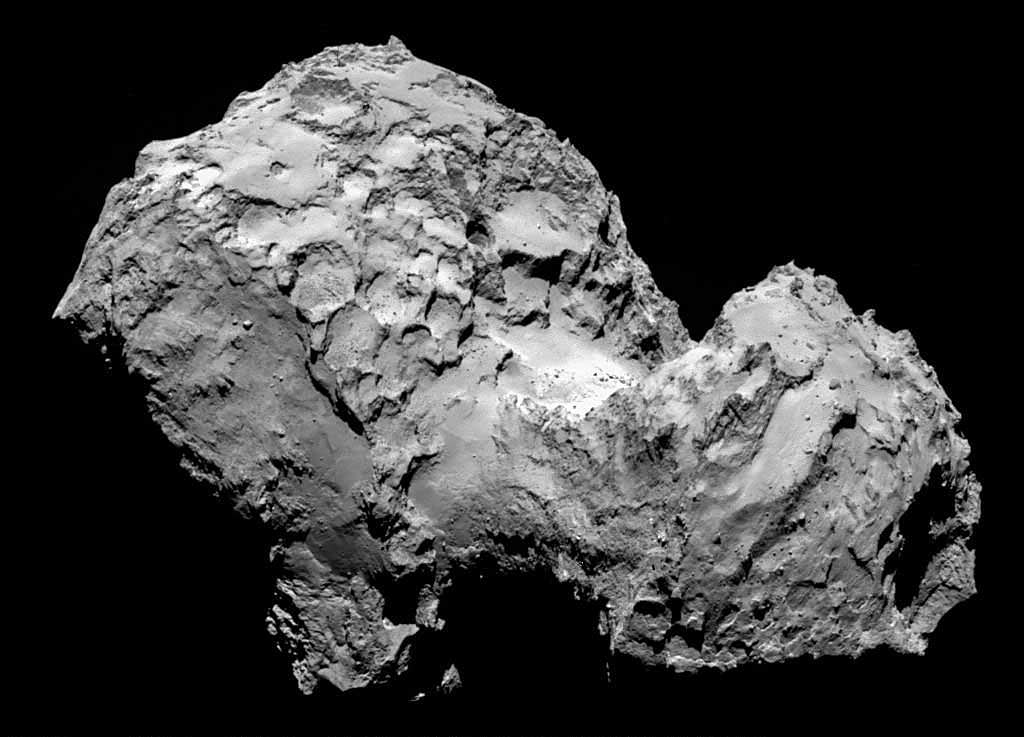Sometimes, space probes that have long since ceased sending back data can still usher in new discoveries. That was the case recently when scientists used data from Rosetta, a probe that eventually crashed into comet 67P/Churyumov-Gerasimenko in 2016, to understand what changes occur on a comet’s surface as it continues its spin around the Sun.
Continue reading “How Long do Good Landing Sites Last on Comets?”Rosetta’s Philae Lander Was Alive on the Surface of 67P for 63 Hours, Trying to Communicate
In August 2014, the ESA’s Rosetta spacecraft arrived at its destination, Comet 67P/Churyumov-Gerasimenko, after a 10 year journey. Rosetta carried a small companion, the Philae Lander. On November 12th, Philae was sent to the surface of Comet 67P. Unfortunately, things didn’t go exactly as planned, and the lander’s mission lasted only 63 hours.
During that time, it gathered what data it could. But mission scientists weren’t certain of its precise location, meaning its data was difficult to interpret accurately. Only when scientists knew precisely where Philae was located on the comet, could they make best use of all of its data.
Continue reading “Rosetta’s Philae Lander Was Alive on the Surface of 67P for 63 Hours, Trying to Communicate”Rosetta Saw the Building Blocks of Life on Comet 67P

Why is there so little nitrogen in Comet 67P/Churyumov-Gerasimenko (67P)? That’s a question scientists asked themselves when they looked at the data from the ESA’s Rosetta spacecraft. In fact, it’s a question they ask themselves every time they measure the gases in a comet’s coma. When Rosetta visited the comet in 2014, it measured the gases and found that there was very little nitrogen.
In two new papers published in Nature Astronomy, researchers suggest that the nitrogen isn’t really missing at all, it’s just hidden in the building blocks of life.
Continue reading “Rosetta Saw the Building Blocks of Life on Comet 67P”An Astrophotographer Noticed a Chunk of Ice Orbiting Comet 67P in Rosetta’s Photos
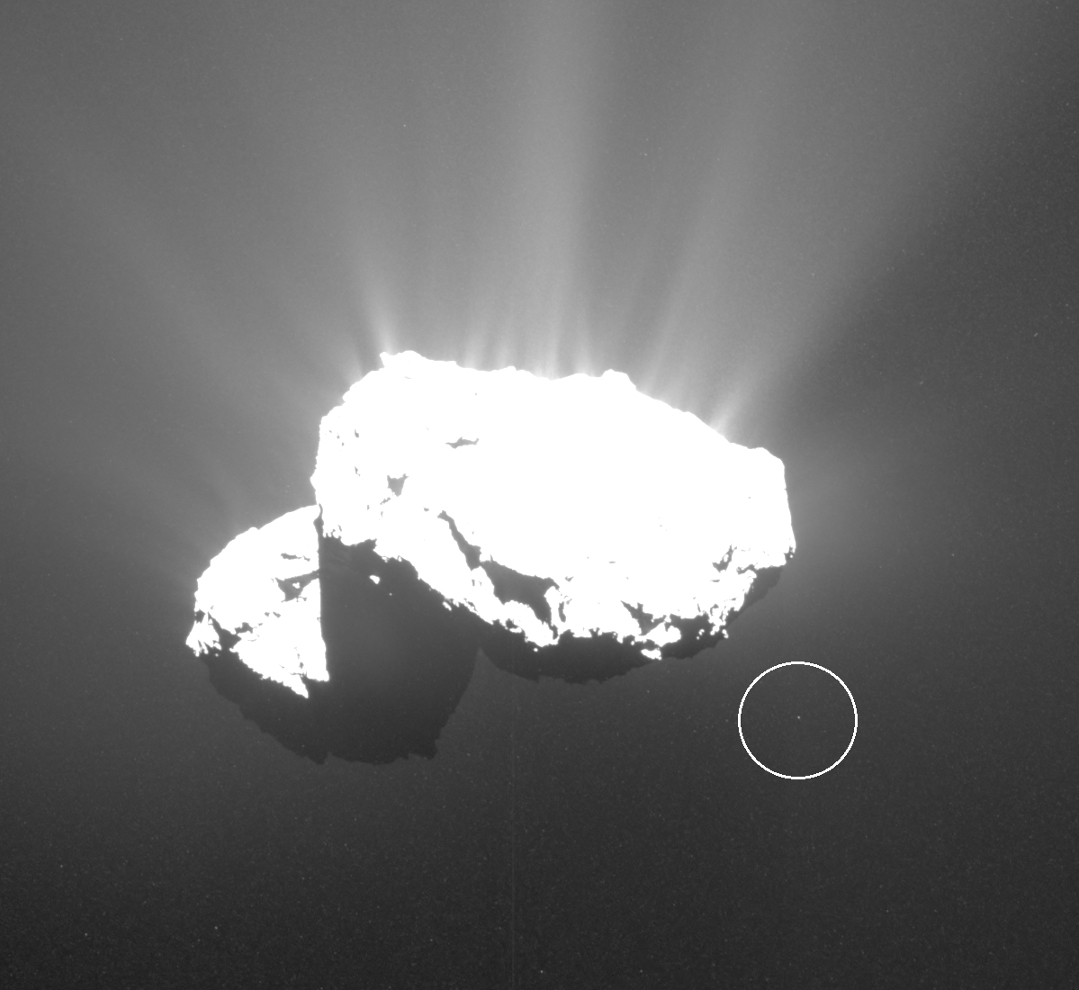
The European Space Agency’s (ESA) Rosetta mission spent two years at the comet 67P/Churyumov-Gerasimenko. At the end of September 2016, its mission was ended when the spacecraft was sent on a collision course into the comet. During its time at comet 67P, it captured a vast amount of images.
The ESA made all those images freely available at their Rosetta website, and now an astro-photographer working with those images has found something interesting: a chunk of ice travelling through space with 67P.
Continue reading “An Astrophotographer Noticed a Chunk of Ice Orbiting Comet 67P in Rosetta’s Photos”Rosetta Flew Through the Bow Shock of Comet 67P Several Times During its Mission

In 2014 , the European Space Agency’s (ESA) Rosetta spacecraft made history when it rendezvoused with Comet 67P/Churyumov-Gerasimenko. This mission would be the first of its kind, where a spacecraft intercepted a comet, followed it as it orbited the Sun, and deployed a lander to its surface. For the next two years, the orbiter would study this comet in the hopes of revealing things about the history of the Solar System.
In this time, Rosetta’s science team also directed the orbiter to look for signs of the comet’s bow shock – the boundary that forms around objects as a result of interaction with solar wind. Contrary to what they thought, a recent study has revealed that Rosetta managed to detect signs of a bow shock around the comet in its early stages. This constitutes the first time in history that the formation of a bow shock has been witnessed in our Solar System. Continue reading “Rosetta Flew Through the Bow Shock of Comet 67P Several Times During its Mission”
New Image Shows the Rugged Landscape of Comet 67P
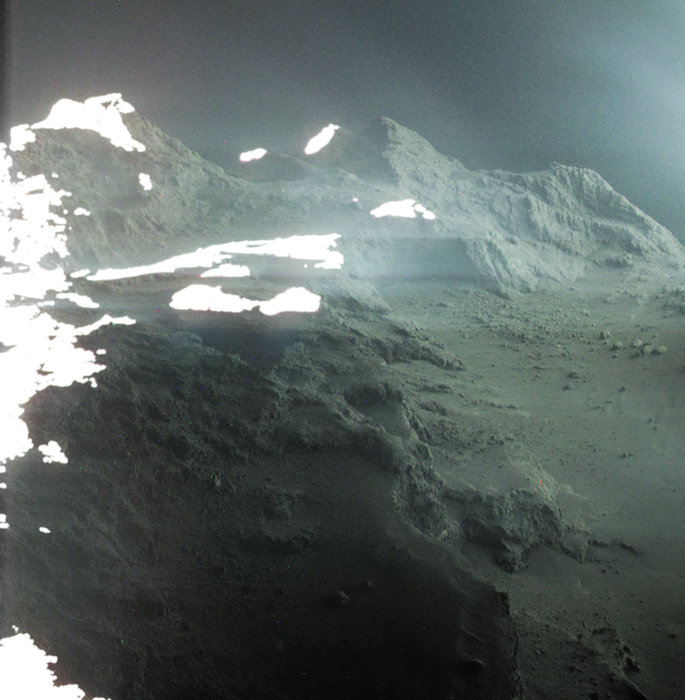
In March of 2004, the European Space Agency’s Rosetta spacecraft blasted off from French Guiana aboard an Ariane 5 rocket. After ten years, by November of 2014, the spacecraft rendezvoused with its target – Comet 67P/Churyumov-Gerasimenko (67P/C-G). Over the more than two years that followed, the spacecraft remained in orbit of this comet, gathering information on its surface, interior, and gas and dust environment.
And on September 30th, 2016, Rosetta came closer than ever to the surface of 67P/C-G and concluded its mission with a controlled impact onto the surface. Since that time, scientists have still been processing all the data the spacecraft collected during its mission. This included some awe-inspiring photographs of the comet’s surface that were obtained shortly after the spacecraft made its rendezvous with 67P/C-G.
Continue reading “New Image Shows the Rugged Landscape of Comet 67P”
I Can’t Stop Watching This Amazing Animation from Comet 67P
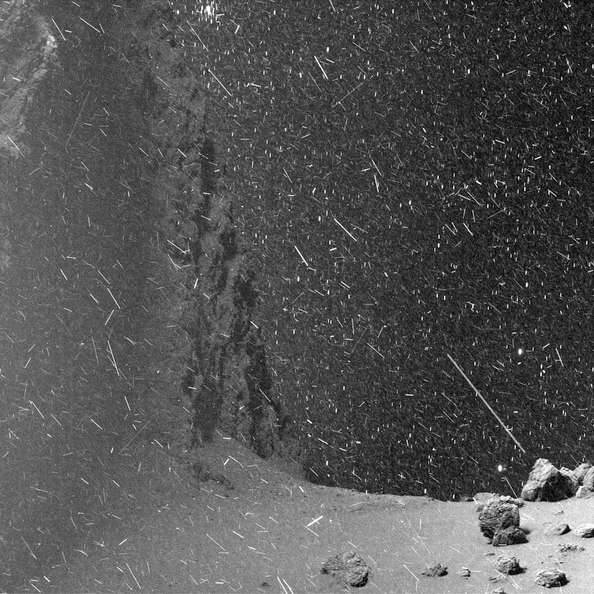
The European Space Agency’s Rosetta mission was an ambitious one. As the first-ever space probe to rendezvous with and then orbit a comet, Rosetta and its lander (Philae) revealed a great deal about the comet 67p/Churyumov-Gerasimenko. In addition to the learning things about the comet’s shape, composition and tail, the mission also captured some incredible images of the comet’s surface before it ended.
For instance, Rosetta took a series of images on June 1st, 2016, that showed what looks like a blizzard on the comet’s surface. Using these raw images (which were posted on March 22nd, 2018), twitter user landru79 created an eye-popping video that shows just what it would be like to stand on the comet’s surface. As you can see, its like standing in a blizzard on Earth, though scientists have indicated that it’s a little more complicated than that.
The video, which consists of 25 minutes worth of images taken by Rosetta’s Optical, Spectroscopic, and Infrared Remote Imaging System (OSIRIS), was posted by landru79 on April 23rd, 2018. It shows the surface of 67p/Churyumov-Gerasimenko on the loop, which lends it the appearance of panning across the surface in the middle of a snowstorm.
#ROSETTA ? OSIRIS #67P/CHURYUMOV-GERASIMENKO new albums ?–ROSETTA EXTENSION 2 MTP030– Miércoles 1 Junio 2016 all filters stacked pic.twitter.com/Bf173Z5g79
— landru79 (@landru79) April 23, 2018
However, according to the ESA, the effect is likely caused by three separate phenomena. For instance, the snow-like particles seen in the video are theorized to be a combination of dust from the comet itself as well as high-energy particles striking the camera. Because of OSIRIS’ charge-coupled device (CCD) – a radiation-sensing camera – even invisible particles appear like bright streaks when passing in front of it.
As for the white specks in the background, those are stars belonging to the Canis Major constellation (according to ESA senior advisor Mark McCaughrean). Since originally posting the video, landru79 has posted another GIF on Twitter (see below) that freezes the starfield in place. This makes it clearer that the comet is moving, but the stars are remaining still (at least, relative to the camera’s point of view).
And of course, the entire video has been sped up considerably for dramatic effect. According to a follow-up tweet posted by landru79, the first image was shot on June 1st, 2016 at 3.981 seconds past 17:00 (UTC) while the last one was shot at 170.17 seconds past 17:25.
Si apilamos todo el set alineando con las estrellas de fondo se distingue mejor que son estrellas y q es polvo (olvidaos de rayos cósmicos ) #ROSETTA ? OSIRIS #67P/CHURYUMOV-GERASIMENKO new albums ?–ROSETTA EXTENSION 2 MTP030– Miércoles 1 Junio 2016 all filters stacked? pic.twitter.com/UyZ628JxKP
— landru79 (@landru79) April 24, 2018
Still, one cannot deny that it is both captivating and draws attention to what Rosetta the mission accomplished. The mission launched in 2004 and reached 67P/Churyumov-Gerasimenko in 2014. After two years of gathering data, it was deliberately crashed on its surface in 2016. And yet, years later, what it revealed is still captivating people all over the world.
Further Reading: Live Science, Gizmodo
Rosetta’s 67P Is The Result Of A Collision Of Two Comets
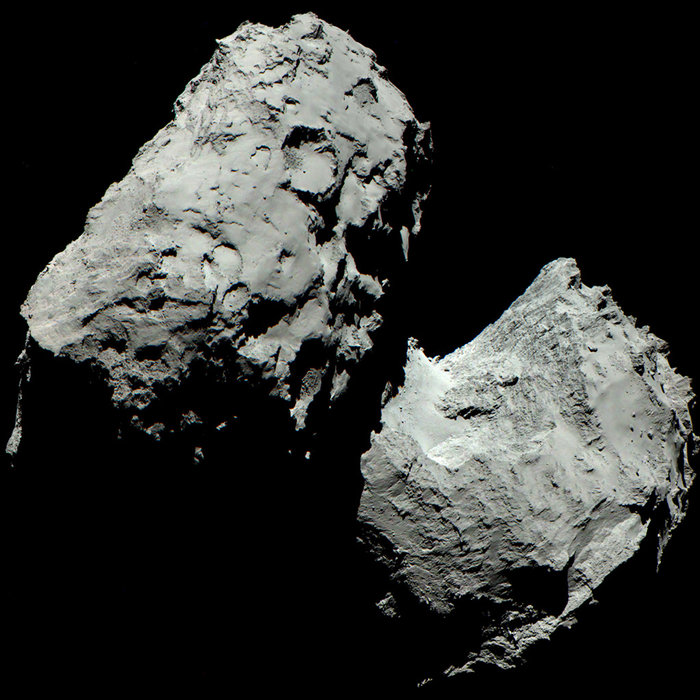
Ever since we’ve been able to get closer looks at comets in our Solar System, we’ve noticed something a little puzzling. Rather than being round, they’re mostly elongated or multi-lobed. This is certainly true of Comet 67P/Churyumov-Gerasimenko (67P or Chury for short.) A new paper from an international team coordinated by Patrick Michel at France’s CNRS explains how they form this way.
The European Space Agency (ESA) spacecraft Rosetta visited 67P in 2014, end even placed its lander Philae on the surface. Rosetta spent 17 months orbiting 67P, and at its closest approach, Rosetta was only 10 km (6 mi) from 67P’s surface. Rosetta’s mission ended with its guided impact into 67P’s surface in September, 2016, but the attempt to understand the comet and its brethren didn’t end then.
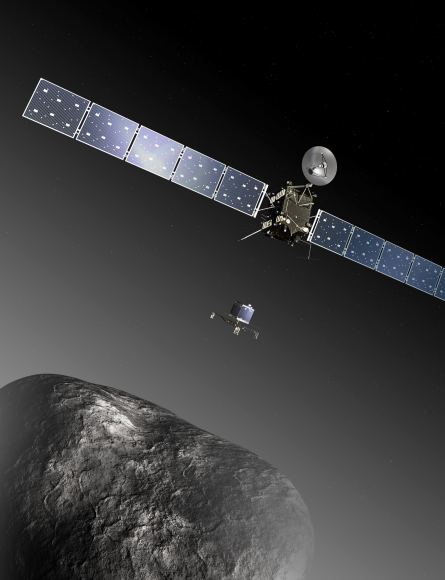
Though Rosetta’s pictures of 67P are the most detailed comet pictures we have, other spacecraft have visited other comets. And most of those other comets appear elongated or multi-lobed, too. Scientists explain these shapes with a “comet merger theory.” Two comets collide, creating the multi-lobed appearance of comets like 67P. But there’s been a problem with that theory.
In order for comets to merge and come out looking the way they do, they would have to merge very slowly, or else they would explode. They would also have to be very low-density, and be very rich in volatile elements. The “comet merger theory” also says that these types of gentle mergers between comets would have to have happened billions of years ago, in the early days of the Solar System.
The problem with this theory is, how could bodies like 67P have survived for so long? 67P is fragile, and subjected to repeated collisions in its part of the Solar System. How could it have retained its volatiles?
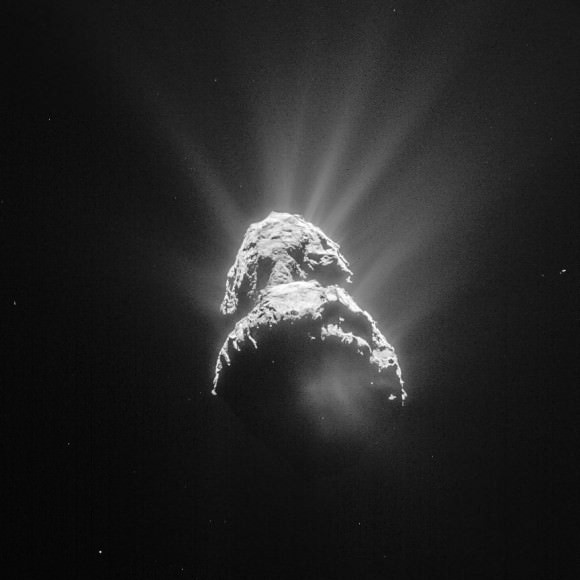
In the new paper, the research team ran a simulation that answers these questions.
The simulation showed that when two comets meet in a destructive collision, only a small portion of their material is pulverized and reduced to dust. On the sides of the comets opposite from the impact point, materials rich in volatiles withstand the collision. They’re still ejected into space, but their relative speed is low enough for them to join together in accretion. This process forms many smaller bodies, which keep clumping up until they form just one, larger body.
The most surprising part of this simulation is that this entire process may only take a few days, or even a few hours. The whole process explains how comets like 67P can keep their low density, and their abundant volatiles. And why they appear multi-lobed.

The simulation also answered another question: how can comets like 67P survive for so long?
The team behind the simulation thinks that the process can take place at speeds of 1 km/second. These speeds are typical in the Kuiper Belt, which is the disc of comets where 67P has its origins. In this belt, collisions between comets are a regular occurrence, which means that 67P didn’t have to form in the early days of the Solar System as previously thought. It could have formed at any time.
The team’s work also explains the surface appearance of 67P and other comets. They often have holes and stratified layers, and these features could have formed during re-accretion, or sometime after its formation.
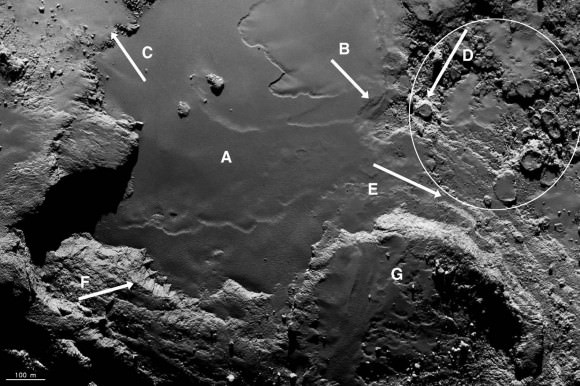
One final point from the study concerns the composition of comets. One reason they’re a focus of such intense interest is their age. Scientists have always thought of them as ancient objects, and that studying them would allow us to look back into the primordial Solar System.
Though 67P—and other comets—may have formed much more recently than we used to believe, this process shows that there is no significant amount of heating or compaction during the collision. As a result, their original composition from the the early days of the Solar System is retained intact. No matter when 67P formed, it’s still a messenger from the formative days.
You can watch a video from the simulation here: http://www.dropbox.com/s/u7643hanvva57rp/Catastrophic%20disruptions.mp4?dl=0
This was the Snowstorm Rosetta Saw When it Got 79 km Away From Comet 67P

In August of 2014, the ESA’s Rosetta mission made history when it rendezvoused with the Comet 67P/Churyumov–Gerasimenko. For the next two years, the probe flew alongside the comet and conducted detailed studies of it. And in November of 2014, Rosetta deployed its Philae probe onto the comet, which was the first time in history that a lander was deployed to the surface of a comet.
During the course of its mission, Rosetta revealed some truly remarkable things about this comet, including data on its composition, its gaseous halo, and how it interacts with solar wind. In addition, the probe also got a good look at the endless stream of dust grains that were poured from the comet’s surface ice as it approached the Sun. From the images Rosetta captured, which the ESA just released, it looked a lot like driving through a snowstorm!
The image below was taken two years ago (on January 21st, 2016), when Rosetta was at a distance of 79 km from the comet. At the time, Rosetta was moving closer following the comet reaching perihelion, which took place during the previous August. When the comet was at perihelion, it was closer to the Sun and at its most active, which necessitated that Rosetta move farther away for its own protection.
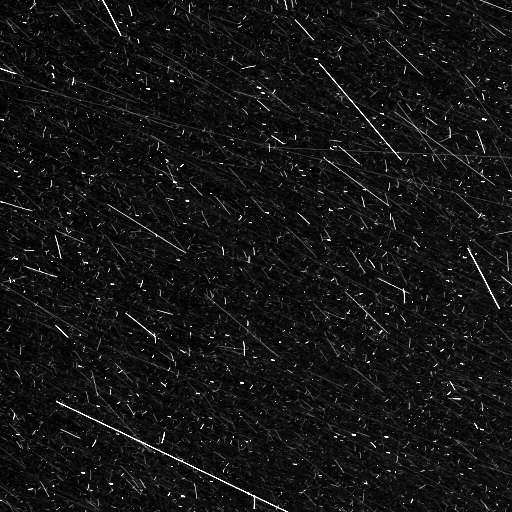
As you can see from the image, the environment around the comet was extremely chaotic, even though it was five months after the comet was at perihelion. The white streaks reveal the dust grains as they flew in front of Rosetta’s camera over the course of a 146 second exposure. For the science team directing Rosetta, flying the spacecraft through these dust storms was like trying to drive a car through a blizzard.
Those who have tried know just how dangerous this can be! On the one hand, visibility is terrible thanks to all the flurries. On the other, the only way to stay oriented is to keep your eyes pealed for any landmarks or signs. And all the while, there is the danger of losing control and colliding with something. In much the same way, passing through the comet’s dust storms was a serious danger to the spacecraft.
In addition to the danger of collisions, flying through these clouds was also hazardous for the spacecraft’s navigation system. Like many robotic spacecraft, Rosetta relies on star trackers to orient itself – where it recognizes patterns in the field of stars to orient itself with respect to the Sun and Earth. When flying closer to the comet, Rosetta’s star trackers would occasionally become confused by dust grains, causing the craft to temporarily enter safe mode.
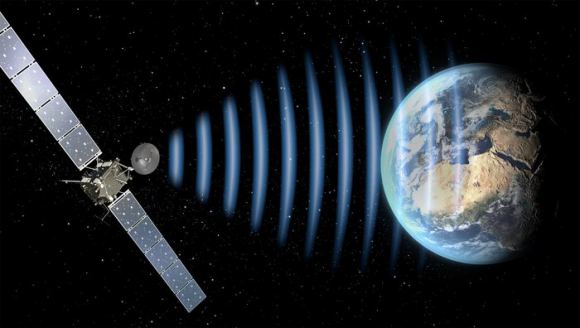
This occurred on March 28th, 2015 and again on May 30th, 2016, when Rosetta was conducting flybys that brought it to a distance of 14 and 5 km from the comet’s surface, respectively. On both occasions, Rosetta’s navigation system suffered from pointing errors when it began tracking bright dust grains instead of stars. As a result, on these occasions, the mission team lost contact with the probe for 24 hours.
As Patrick Martin, the ESA’s Rosetta mission manager, said during the second event:
“We lost contact with the spacecraft on Saturday evening for nearly 24 hours. Preliminary analysis by our flight dynamics team suggests that the star trackers locked on to a false star – that is, they were confused by comet dust close to the comet, as has been experienced before in the mission.”
Despite posing a danger to Rosetta’s solar arrays and its navigation system, this dust is also of high scientific interest. During the spacecraft’s flybys, three of its instruments studied tens of thousands of grains, analyzing their composition, mass, momentum and velocity, and also creating 3D profiles of their structure. By studying these tiny grains, scientists were also able to learn more about the bulk composition of comets.

Before it reached its grand finale and crashed into the comet’s surface on September 30th, 2016, Rosetta made some unique scientific finds about the comet. These included mapping the comet’s surface features, discerning its overall shape, analyzing the chemical composition of its nucleus and coma, and measuring the ratio of water to heavy water on its surface.
All of these findings helped scientists to learn more about how our Solar System formed and evolved, and shed some light on how water was distributed throughout our Solar System early in its history. For instance, by determining that the ratio of water to heavy water on the comet was much different than that of Earth’s, scientists learned that Earth’s water was not likely to have come from comets like Comet 67P/Churyumov–Gerasimenko.
On top of that, the spacecraft took more than a hundred thousand image of the comet with its high-resolution OSIRIS camera (including the ones shown here) and its navigation camera. These images can be perused by going to the ESA’s image browser archive. I’m sure you’ll agree, they are all as beautiful as they are scientifically relevant!
Further Reading: ESA
Rosetta Team Finds New, Final Image Hiding in the Data

ESA scientists have found one additional image from the Rosetta spacecraft hiding in the telemetry. This new image was found in the last bits of data sent by Rosetta immediately before it shut down on the surface of Comet 67P/Churyumov–Gerasimenko last year.
The new image shows a close-up shot of the rocky, pebbly surface of the comet, and looks somewhat reminiscent of the views the Huygens lander took of the surface of Saturn’s moon Titan.

Planetary astronomer Andy Rivkin noted on Twitter that for size context, he estimates the block just right of center looks to be about the size of a hat. That’s a fun comparison to have (not to mention thinking about hats on Comet 67P!)
The picture has a scale of 2 mm/pixel and measures about 1 m across. It’s a really ‘close’ close-up of Comet 67P.
“The last complete image transmitted from Rosetta was the final one that we saw arriving back on Earth in one piece moments before the touchdown at Sais,” said Holger Sierks, principal investigator for the OSIRIS camera at the Max Planck Institute for Solar System Research in Göttingen, Germany. “Later, we found a few telemetry packets on our server and thought, wow, that could be another image.”
The team explains that the image data were put into telemetry ‘packets’ aboard Rosetta before they were transmitted to Earth, and the final images were split into six packets. However, for the very last image, the transmission was interrupted after only three full packets. The incomplete data was not recognized as an image by the automatic processing software, but later, the engineers in Göttingen could make sense of these data fragments to reconstruct the image.
You’ll notice it is rather blurry. The OSIRIS camera team says this image only has about 53% of the full data and “therefore represents an image with an effective compression ratio of 1:38 compared to the anticipated compression ratio of 1:20, meaning some of the finer detail was lost.”
That is, it gets a lot blurrier as you zoom in compared with a full-quality image. They compared it to compressing an image to send via email, versus an uncompressed version that you would print out and hang on your wall.
Rosetta’s final resting spot is in a region of active pits in the Ma’at region on the two-lobed, duck-shaped comet.
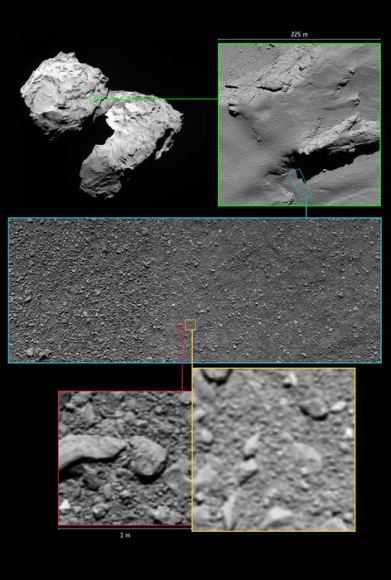
Launched in 2004, Rosetta traveled nearly 8 billion kilometers and its journey included three Earth flybys and one at Mars, and two asteroid encounters. It arrived at the comet in August 2014 after being in hibernation for 31 months.
After becoming the first spacecraft to orbit a comet, it deployed the Philae lander in November 2014. Philae sent back data for a few days before succumbing to a power loss after it unfortunately landed in a crevice and its solar panels couldn’t receive sunlight.
But Rosetta showed us unprecedented views of Comet 67P and monitored the comet’s evolution as it made its closest approach and then moved away from the Sun. However, Rosetta and the comet moved too far away from the Sun for the spacecraft to receive enough power to continue operations, so the mission plan was to set the spacecraft down on the comet’s surface.
And scientists have continued to sift through the data, and this new image was found. Who knows what else they’ll find, hiding the data?


